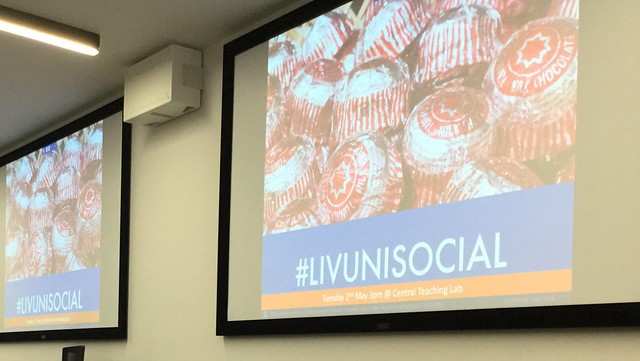Supriya Garikapti attended one of the eLearning Unit’s CPD sessions on the Use of Twitter in Higher Education. She contacted me soon after and asked if I’d like to share some of my work at an upcoming Social Media and External Engagement impact workshop in the Management School. I was only too happy to oblige. You can view my presentation here which is entitled Twitter Top Tips.
The basis for the workshop was to share a wide range of good practice from colleagues across the school. A great deal of work is already underway regarding maintaining the excellent standing of the school in the upcoming REF assessment in 2021. It is with the knowledge that Lord Nicholas Sterns’s recent recommendations look likely to guide the shape of the next assessment exercise that I’ve highlighted the three impact recommendations below:
Recommendation 5: Institutions should be given more flexibility to showcase their interdisciplinary and collaborative impacts by submitting ‘institutional’ level impact case studies, part of a new institutional level assessment.
Recommendation 6: Impact must be based on research of demonstrable quality. However, case studies could be linked to a research activity and a body of work as well as to a broad range of research outputs.
Recommendation 7: Guidance on the REF should make it clear that impact case studies should not be narrowly interpreted, need not solely focus on socio-economic impacts but should also include impact on government policy, on public engagement and understanding, on cultural life, on academic impacts outside the field, and impacts on teaching.
There is increasing evidence of the value of blogging about your work and sharing it to wider audience via social media channels such as Twitter. There are also plenty of handy tips to get you started and help you effectively promote your work. The eLearning Unit regularly run sessions on social media such as An Introduction to Twitter and Getting more out of Twitter. Get in touch with the eLearning Unit in the Centre for Innovation in Education to find out more. Right, that’s enough advertising!
HSS Press Officer Matt Hurst kindly didn’t speak to a PowerPoint presentation which allowed my #LIVUNISOCIAL event advert to gain maximum exposure! (I promise that’s the last advert!)
Matt informed the audience about the role of the Press Office in supporting staff to make the most of their press contacts, brokering relationships with major media outlets, providing media training for academic staff, as well as providing useful advice if things go wrong on social media. In the context of the events theme, visibility on news, radio and television is considered a pathway to impact and may be looked on favourably in the REF submission. To that end, they are in the process of setting up a state of the art broadcast suite in partnership with Globelynx.
Following on from this was Paul Sapple, Public Engagement With Research manager for the University. He impressed upon the gathered attendees the importance of impact and the support he provides in helping staff along that pathway. He shared with us some of Supriya’s recent research its impact. The case study focused on empowering young girls in India to understand and manage their fertility.
Jennifer Johns shared her experiences of writing about Brexit for the online publication the The Conversation. For those unfamiliar with the name, it is an independent source of news and views, sourced from the academic and research community and is publicly accessible online. Contributions from the University of Liverpool are high with over 130 academics and researchers. Publishing in this way opened up opportunities to further increase impact as it led to work on BBC radio and Slovak TV. The article was widely shared across blogs and Twitter and while this was a pleasing when looking at the analytics (1700 views), she stated that once published here it’s no longer in your hands. The drawback to wiring a piece on a contentious topic is the comments she received on the site. Comments on websites sometimes bring out the keyboard warriors and trolls who are only in it for the “lulz”.
My knowledge of the intricacies of the tariffs applied to the sale of alcohol in Canada increased tenfold after hearing about the internationally recognised work of Andrew Smith. He didn’t seem to need to use social media for impact, as his work was widely reported in the Canadian press as part of a major legal case. However, he continued to help keep the story alive on his regularly updated blog https://pastspeaks.com/
As the audience dwindled due teaching commitments, many people will have missed what was certainly my favourite presentation of the afternoon. Nick Papageorgiadis shared how he used the openness and immediacy of Twitter to promote the research in his subject area: research on national Intellectual Property (IP). He developed a new index that measures the strength of patent systems of 49 countries, annually, for the years 1998-2015. The index was published at the Journal of World Business and the scores and latest updates of the index are available on this website. His approach to using Twitter was very focused. He identified a clear audience for his work, only posted and responded to questions on his research and when retweeting the work of others, he always posted a short comment about the article. In particular, certain retweets of his work have driven traffic to his patent systems website, significantly so in Australia and Finland where his work has informed governmental reports. Summing up he suggested there are many pro’s to using Twitter. It’s very useful to share the work you have done and if used alongside a website, you can easily track the impact of your tweets. Having it all online aids the evidence collection process. According to Nick, there is a price to pay for working in this way. He states that it took some time to get started and maintain a presence on Twitter, and that the workload allocation model does not distinguish this activity as teaching or scholarship. This begs the question when will we get to a stage where our work activity on Social Media is recognised and supported?
Alex



One thought on “Telling Stories: ULMS Social Media and External Engagement workshop”